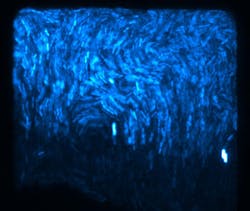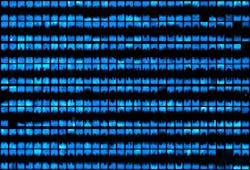Neon sign-like biosensor comprises millions of glowing bacteria
Researchers at the University of California, San Diego (UC San Diego) have created a living biosensor comprised of millions of bacterial cells that periodically fluoresce in unison like blinking light bulbs.
First, they attached a fluorescent protein to the biological clocks of the bacteria, which enabled them to synchronize the clocks of the thousands of bacteria within a colony and then synchronize thousands of the blinking bacterial colonies to glow on and off in unison. Then, the researchers engineered a simple bacterial sensor capable of detecting low levels of arsenic. In this biosensor, decreases in the frequency of the oscillations of the cells' blinking pattern indicate the presence and amount of the arsenic poison.
Because bacteria are sensitive to many kinds of environmental pollutants and organisms, the researchers believe this approach could be also used to design low-cost bacterial biosensors capable of detecting an array of heavy metal pollutants and disease-causing organisms. And because the sensor is composed of living organisms, it can respond to changes in the presence or amount of the toxins over time as opposed to many chemical sensors, which are used for one-time measurements, says Jeff Hasty, a professor of biology and bioengineering at UC San Diego, who led the work. "Because the bacteria respond in different ways to different concentrations by varying the frequency of their blinking pattern, they can provide a continual update on how dangerous a toxin or pathogen is at any one time," he says.
The development of the techniques to make the sensor and the flashing display built on the work of the researchers in the Division of Biological Sciences and School of Engineering, which they published in two previous Nature papers over the past four years. In the first paper, they demonstrated how they had developed a way to construct a robust and tunable biological clock to produce flashing, glowing bacteria. In the second paper, published in 2010, the researchers showed how they designed and constructed a network, based on a communication mechanism employed by bacteria, that enabled them to synchronize all of the biological clocks within a bacterial colony so that thousands of bacteria would blink on and off in unison.
"Many bacteria species are known to communicate by a mechanism known as quorum sensing; that is, relaying between them small molecules to trigger and coordinate various behaviors," says Hasty, explaining how the synchronization works within a bacterial colony. "Other bacteria are known to disrupt this communication mechanism by degrading these relay molecules."
But the researchers found the same method couldnât be used to instantaneously synchronize millions of bacteria from thousands of colonies. With a bunch of cells oscillating, the signal propagation time is too long to instantaneously synchronize 60 million other cells via quorum sensing, explains Hasty. But the researchers discovered that each of the colonies emit gases that, when shared among the thousands of other colonies within a specially designed microfluidic chip, can synchronize all of the millions of bacteria in the chip. "The colonies are synchronized via the gas signal, but the cells are synchronized via quorum sensing. The coupling is synergistic in the sense that the large, yet local, quorum communication is necessary to generate a large enough signal to drive the coupling via gas exchange," adds Hasty.
Graduate students Arthur Prindle, Phillip Samayoa, and Ivan Razinkov designed the microfluidic chips, which for the largest ones contain 50 to 60 million bacterial cells and are about the size of a paper clip or a microscope cover slip. The smaller microfluidic chips, which contain approximately 2.5 million cells, are about a tenth of the size of the larger chips.
Each of the blinking bacterial colonies comprise what the researchers call a "biopixel," an individual point of light much like pixels on a computer monitor or television screen. The larger microfluidic chips contain about 13,000 biopixels, while the smaller chips contain about 500 pixels.
Hasty believes that within five years, a small handheld sensor could be developed that would take readings of the oscillations from the bacteria on disposable microfluidic chips to determine the presence and concentrations of various toxic substances and disease-causing organisms in the field.
The work has been published in this weekâs advance online issue of Nature; for more information, please visit http://www.nature.com/nature/journal/vaop/ncurrent/full/nature10722.html.
-----
Follow us on Twitter, 'like' us on Facebook, and join our group on LinkedIn
Follow OptoIQ on your iPhone; download the free app here.
Subscribe now to BioOptics World magazine; it's free!



